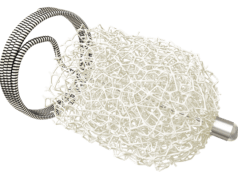 A population-based cohort study by Viknesh Sounderajah and colleagues at Imperial College in London, UK, found an increased risk of abdominal cancer associated with endovascular anurysm repair—irrespective of whether or not CT surveillance was included in follow-up post-EVAR. Presenting the data at the Vascular Societies’ Annual Scientific Meeting (VSASM; 27–29 November, Glasgow, UK), Sounderajah commented the data “feeds in to the National Institute of Health and Care Excellence (NICE) abdominal aortic aneurysm guidelines debate.”
A population-based cohort study by Viknesh Sounderajah and colleagues at Imperial College in London, UK, found an increased risk of abdominal cancer associated with endovascular anurysm repair—irrespective of whether or not CT surveillance was included in follow-up post-EVAR. Presenting the data at the Vascular Societies’ Annual Scientific Meeting (VSASM; 27–29 November, Glasgow, UK), Sounderajah commented the data “feeds in to the National Institute of Health and Care Excellence (NICE) abdominal aortic aneurysm guidelines debate.”
The study included patients in England, UK, over the age of 50 who had received open or endovascular repair of an abdominal aortic aneurysm (AAA) between April 2005 and March 2013, in either elective or emergency setting, and who received a post-operative diagnosis of cancer.
“Over the last 10 to 15 years, endovascular aneurysm repair (EVAR) has supplanted open repair in many senses for the treatment of symptomatic and threshold aneurysms. As noted in well-known randomised controlled trials, EVAR is traditionally associated with short-term benefits with respect to mortality, morbidity and length of stay,” Sounderajah said at VSASM. “However,” he continued, “more contemporary data suggest that there is a catch-up in late mortality and increased risk of reintervention with respect to the EVAR group.” Sounderajah explained there is a hypothesis that part of the late-stage mortality following EVAR may be due to malignancy burden—an idea which he says is “not often talked about.” The question posed in the study is whether exposure to external radiation from EVAR procedures or CT surveillance as part of the follow-up protocol contributes to abdominal cancer-related mortality in abdominal aortic aneurysm patients receiving EVAR in comparison to open repair. Indeed, Sounderajah notes this hypothesis is in line with findings of oncological studies examining radiotherapy-based treatment for breast cancer and lymphoma, “which shows that there are new instances of malignancy following radiotherapy treatment”.
The primary outcomes of the study were survival free from abdominal malignancy and death from abdominal malignancy, with the secondary outcomes of overall malignancy-free survival and freedom from lung and non-abdominal obesity related cancer. Sounderajah and colleagues also decided to perform a subgroup analysis, comparing patients who received CT scan surveillance on follow-up to those who did not. At baseline, EVAR patients were older (median 76 years versus median 73 years in the open repair arm) with significantly higher percentages of comorbidities.
“With regards to the cause of death,” Sounderajah said, “it is noted that 18% of patients who undergo EVAR succumb to cancer.” This is in comparison to 14.7% for the open repair. At seven years, an increase was found in the proportion of patients admitted with abdominal cancer or abdominal cancer as cause of death in the EVAR group (HR 1.14; 95% CI 1.03–1.27) as well as an increase in the proportion of patients admitted with any type of cancer or cancer as cause of death (HR 1.14; 95% CI 1.03–1.27). Furthermore, the subgroup analysis found no difference in the incidence of abdominal cancer or abdominal cancer as cause of death in EVAR patients receiving CT surveillance or non-CT surveillance (HR 0.87; 95% CI 0.67–1.13; p=0.308).
Sounderajah concluded, “our study suggests there was an increased risk of abdominal malignancy associated with EVAR, irrespective of CT surveillance following the primary procedure. This is the first population-level study to assess this, however we do appreciate there are some limitations with respect to the observational design, confounders that we cannot account for with the dataset, the granularity of the dataset which is often binary in many cases, as well as an ascertainment bias—but we do hope this feeds into the current NICE guidance, as well as the radiation safety understanding.”














This should definitely be brought up for discussion at the Charing Cross Symposium in April!! This could be very important, and yes, the NICE Guidelines may have to reflect this aspect a well…